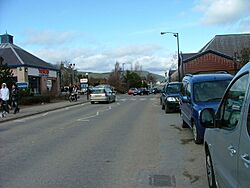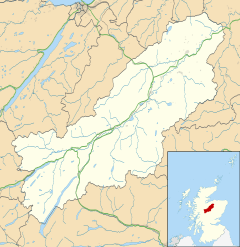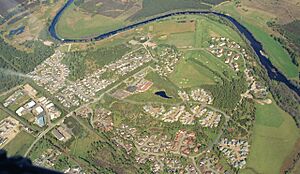Aviemore facts for kids
Quick facts for kids Aviemore
|
|
|---|---|
| Town | |
 A view of Aviemore main street, 2010 |
|
| Population | 3,230 (2020) |
| Language | English Scottish Gaelic |
| OS grid reference | NH898129 |
| • Edinburgh | 90 mi (140 km) |
| • London | 420 mi (680 km) |
| Council area | |
| Country | Scotland |
| Sovereign state | United Kingdom |
| Post town | Aviemore |
| Postcode district | PH22 |
| Dialling code | 01479 |
| Police | Northern |
| Fire | Highlands and Islands |
| Ambulance | Scottish |
| EU Parliament | Scotland |
| UK Parliament |
|
| Scottish Parliament | |
Aviemore (pronounced Av-ee-more) is a lively town and popular holiday spot in the Scottish Highlands. It's located inside the beautiful Cairngorms National Park in Scotland. People love Aviemore for its amazing skiing and other winter sports. It's also a fantastic place for hill-walking and exploring the Cairngorm Mountains. The town is part of the Highland council area, specifically in the Badenoch and Strathspey region.
Contents
What Does the Name Aviemore Mean?
The name Aviemore comes from the Scottish Gaelic words An Aghaidh Mhòr. The word Aghaidh might come from an old language called Pictish. It could mean something like "cleft" or a narrow opening between hills.
Aviemore's Story: A Quick Look
How Aviemore Started
People have lived in the Aviemore area for a very long time. There are even ancient stone structures called clava cairns from the Bronze Age still there today.
Aviemore started to grow much bigger in 1898. This happened when it became an important railway junction. The Highland Railway company built homes for its workers and a large hotel. This made the railway a major employer in the town.
Aviemore as a Tourist Spot
Aviemore became one of Scotland's first skiing resorts. A chairlift opened in 1961, making it easy to reach the ski slopes. After this, more and more people moved to Aviemore, and the town's population grew. Today, it's Britain's most visited ski resort in winter.
The original Aviemore Hotel burned down in 1950. In the 1960s, a new big holiday complex called the Aviemore Centre was built on its site. It opened in 1966 and quickly became a top Scottish tourist destination. Even members of the Royal Family visited the Centre often. A popular TV show called It's a Christmas Knockout was filmed there twice in the 1970s.
Recent Changes in Aviemore
Around 1998, many of the older buildings in the Aviemore Centre were taken down. This was part of a big plan to update the area. New visitor buildings were put up, but some of the other fun activities were not replaced. Since 2006, local groups have worked to attract even more tourists to Aviemore.
Near Aviemore, you can find the only freely roaming reindeer herd in the United Kingdom. They live in Glen More.
The Cairngorm Mountain Railway is a fun way to go up the mountain. However, it was closed in October 2018 because of safety concerns. Work is being done to fix it.
In 2019, plans were made for a new hospital in Aviemore. This 24-bed facility will have many rooms for check-ups and treatments. It will also have X-ray machines and a place for paramedics. It was expected to open in spring 2021.
Also in 2019, parts of the 25th James Bond film, No Time to Die, were filmed in Aviemore and the nearby Cairngorms National Park. The film crew even built temporary homes in a car park in town!
Learning in Aviemore
Aviemore has its own primary school for children aged 3 to 12. This school, called Aviemore Primary School, opened in 2012. It has 10 classrooms, special rooms for different activities, a main hall, and facilities for younger children. It also has a sports hall and a fenced sports pitch.
Inside the school building, there's also the Aviemore Community Centre. This centre offers a gym, meeting rooms, a dance studio, and a library for everyone in the community. The school also helps primary students with special learning needs from the wider Badenoch and Strathspey area. Most students from Aviemore Primary School go on to attend Kingussie High School after they finish primary school.
Aviemore's Location and Weather
Aviemore is located on the B9152 road, which used to be the main A9 road. The town also has Aviemore railway station, which is on the main train line connecting Inverness and Perth. Aviemore is also the starting point for the Strathspey Railway, which is a special old train line that runs for fun.
Aviemore has a type of weather called an oceanic climate. This means it has cool temperatures and rain throughout the year. The warmest temperature ever recorded was 31.3 degrees Celsius (about 88 degrees Fahrenheit) on June 28, 2018. The coldest was in December 1995.
| Climate data for Aviemore (228 m asl, averages 1991–2020, extremes 1956–present) | |||||||||||||
|---|---|---|---|---|---|---|---|---|---|---|---|---|---|
| Month | Jan | Feb | Mar | Apr | May | Jun | Jul | Aug | Sep | Oct | Nov | Dec | Year |
| Record high °C (°F) | 12.5 (54.5) |
15.8 (60.4) |
23.0 (73.4) |
24.2 (75.6) |
29.0 (84.2) |
31.3 (88.3) |
31.0 (87.8) |
30.6 (87.1) |
26.7 (80.1) |
25.5 (77.9) |
16.7 (62.1) |
14.8 (58.6) |
31.3 (88.3) |
| Mean daily maximum °C (°F) | 5.3 (41.5) |
6.0 (42.8) |
8.2 (46.8) |
11.4 (52.5) |
14.6 (58.3) |
16.7 (62.1) |
18.8 (65.8) |
18.1 (64.6) |
15.7 (60.3) |
11.6 (52.9) |
7.9 (46.2) |
5.4 (41.7) |
11.7 (53.1) |
| Daily mean °C (°F) | 2.3 (36.1) |
2.7 (36.9) |
4.3 (39.7) |
6.8 (44.2) |
9.5 (49.1) |
12.2 (54.0) |
14.2 (57.6) |
13.6 (56.5) |
11.4 (52.5) |
7.9 (46.2) |
4.6 (40.3) |
2.2 (36.0) |
7.7 (45.9) |
| Mean daily minimum °C (°F) | −0.6 (30.9) |
−0.6 (30.9) |
0.5 (32.9) |
2.1 (35.8) |
4.4 (39.9) |
7.6 (45.7) |
9.5 (49.1) |
9.2 (48.6) |
7.2 (45.0) |
4.2 (39.6) |
1.4 (34.5) |
−0.9 (30.4) |
3.7 (38.6) |
| Record low °C (°F) | −21.5 (−6.7) |
−26.2 (−15.2) |
−17.4 (0.7) |
−9.5 (14.9) |
−5.1 (22.8) |
−3.2 (26.2) |
−1.1 (30.0) |
−2.7 (27.1) |
−4.6 (23.7) |
−8.6 (16.5) |
−17.1 (1.2) |
−24.6 (−12.3) |
−26.2 (−15.2) |
| Average rainfall mm (inches) | 117.7 (4.63) |
86.7 (3.41) |
74.8 (2.94) |
59.5 (2.34) |
64.9 (2.56) |
66.4 (2.61) |
64.0 (2.52) |
72.7 (2.86) |
71.5 (2.81) |
100.1 (3.94) |
96.8 (3.81) |
109.7 (4.32) |
984.9 (38.78) |
| Average rainy days (≥ 1 mm) | 16.5 | 14.3 | 14.1 | 11.8 | 13.2 | 12.6 | 13.0 | 13.1 | 12.8 | 15.9 | 15.5 | 15.3 | 168.1 |
| Mean monthly sunshine hours | 36.2 | 64.5 | 104.1 | 142.1 | 181.0 | 143.4 | 143.5 | 133.3 | 110.7 | 73.9 | 46.4 | 29.7 | 1,208.8 |
| Source: Met Office | |||||||||||||
Gallery
See also
 In Spanish: Aviemore para niños
In Spanish: Aviemore para niños







